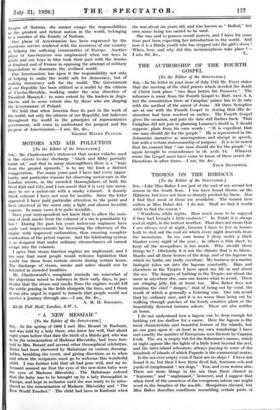MOTORS AND AIR POLLUTION
[To the Editor of the SPECTATOR.] Charlesworth's statement that motor vehicles used in the streets to-day discharge " black and filthy partially burnt oil," and that in many thoroughfares there is a " haze from the ground upwards," is to say the least a distinct exaggeration. For many years past I have had every oppor- tunity and particular reasons for observing motor-cars in the London streets, in the crowded thoroughfares of both the West End and City, and I can assert that it is very rare nowa- days to see a motor-car with a smoky exhaust. A densely black' exhaust I have not seen for months. Since the lett& appeared I have paid particular attention to the point and have observed at the worst only a light and almost invisible vapour. In many cases it is quite invisible.
Does your correspondent not know that to allow the emis- sion of dark smoke from the exhaust of a car is punishable by law ? During the past ten years motor-car engineers have made vast improvements by increasing the efficiency of the engine with improved carburation, thus ensuring complete combustion of the petrol vapour. And the lubricating system is so designed that under ordinary circumstances oil cannot escape into the exhaust.
I agree that steam, traction engines are unpleasant, and I am sure that most people would welcome legislation that would bar them from certain streets during certain hours. The discharge of steam, smoke and ashes should not be tolerated in crowded localities.
_ Mr. Charlesworth's complaint reminds me somewhat of the objections raised to railways in their early days, in par_ ticular that the steam and smoke from the engines would kill the cattle grazing-in the fields alongside the lines, and I think it was also urged in regard to tunnels that people would not survive a journey through one.—I am, Sir, &c.,


































 Previous page
Previous page